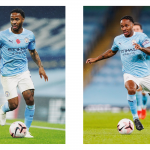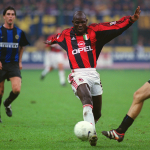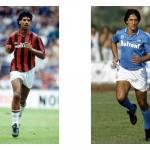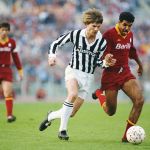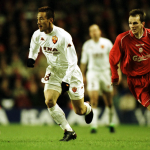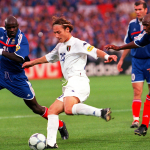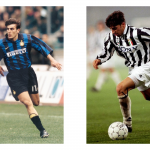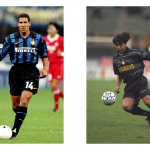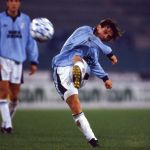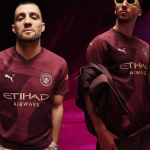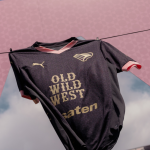
The evolution of the football shirts fit
From the slim of the 80s to the baggy of today
November 11th, 2020
Football jerseys follow trends as other products do and the fit is one of the things that has changed most visibly over the years. Each sporting era has its own style, its peculiarities and is a symbol of a defined aesthetic standard. The way to wear the jerseys very often depends on the trends that the players with the greatest aesthetic impact have in a given historical moment and consequently the brands that produce and launch football jerseys on the market adapt to the stylistic demand of the market. From the 1980s to today, 5 stylistic eras can be identified which, especially in Italy where the shirt is considered an almost mystical object, have marked the aesthetic change. From the latest fashion of Messi to Platini, from Bellerín to Del Piero, passing from brands and models that have completely revolutionized the style on the pitch.
80s | A primordial slim
The Serie A of the 80s represented for many the golden age of Italian football - and not only technically and tactically. The fit of the jerseys of this decade was decidedly tight, declined according to one's personality: the black and white version of "Le Roi" has always preferred the shirt outside the shorts, while players like Maradona, Socrates, Voller and Scirea have preferred to create a continuum with shorts. The flair and genius against elegance and style, even if the compact fit is the common thread among all the greats of the time.
The physicality of the time is not a predominant feature and the style of the shirts between advantage and charm with the still slender bodies of the players. The physical component, which will gradually evolve over the following decades, will have a great impact on the choice of fit of the game jerseys.
90s | Baggy and cozy
10 years are enough to revolutionize everything. The fit of the 90s is diametrically opposite to what was seen on the Kappa jerseys of Juve and Roma or even on the adidas jerseys of the Verona Italian champion in 1985. Players tend to wear loose jerseys, at least one size larger than the right one, enhancing movements and shots. The Inter of Ronaldo and Zamorano is one of the best photographs, together with Beppe Signori's Lazio and Batistuta's Viola. Brands also change, satisfying the demands of clubs and players and following a trend that seems rampant at the end of the 20th second.
The large and cozy jersey - inserted strictly inside the shorts, which in the meantime begin to stretch - was also useful in the 1vs1 phase: the tugs of the defenders were better noticed if those who suffered them were able to show the referee part of the jersey outside the shorts . Keep the "arbitrage" icon open because it will come in handy later.
2000s | The shirt as a "second skin"
The 2000s can boil down to one word: Kombat. The revolution that Kappa introduces in the 2000-01 season takes the concept of jersey fit to the extreme. The Kombat model is practically a second skin for gamers. The first to wear it will be the AS Roma players, with Totti & Co. who inaugurate the new jersey and the new technical sponsor with the victory of the Scudetto.
It is a jersey with an elasticized fit, aesthetically very particular but at the same time very useful. Being very thin, it was difficult for the opponents to even hold on to the shirt. In those rare cases where the pull was successful, it was so obvious that they forced the referee to blow the whistle. The Kombat thus becomes an important weapon, especially for fast players like Totti and Nakata.
Kombat also made its international debut, with the Italian national team wearing a 1.0 version in Holland-Belgium for Euro2000 and a 2.0 version in the 2002 Japanese World Cup.
10s | The era of hybrid fit
The fit of the shirt continues to evolve, but it gets to the point where there is no single trend. The brands divide and a period begins in which every player and every club makes choices following their own nature, giving priority to comfort and wearability. At the same time, therefore, on the one hand there is Kappa which continues to evolve its Kombat (the most extreme version will be the 2016-17 version that the Napoli players will wear), on the other brands such as Nike and adidas choose an intermediate path. Inter and Milan will almost never wear tight-fitting jerseys, but Adriano and Ibra will never wear jerseys as large as those of the Fenomeno; the same goes for Ronaldinho and Beckham, nowhere near the fit that Weah and Boban preferred.
È l’epoca delle rivoluzioni tecnologiche più importanti: Nike sperimenta e implementa il Dri-Fit, mentre adidas lancia sul mercato la prima maglia che pesa 100g. La tecnologia e la moda nel calcio iniziano ad essere sempre più elementi rilevanti all’interno delle dinamiche del mercato delle maglie, con nuovi brand che puntano a colmare il gap con i grandi colossi.
20s | A new vintage start
Leo Messi is one of the best players in the history of the game, but when it comes to style it is better to look for other references. Yet he was among the first to reintroduce oversize this year. The "baggy" style is found today in players who are more attentive to fashion trends such as Héctor Bellerín, such as Jadon Sancho, such as Serge Gnabry or Neymar. It seems that there is a lot of Allen Iverson in the way these players wear the shirts and in the fit they prefer on the pitch. Then, however, shorts also come into play. The choice of the most hype players is to mix styles: on the one hand the sweaters with wide fit, on the other very short shorts like in the 80s.




























